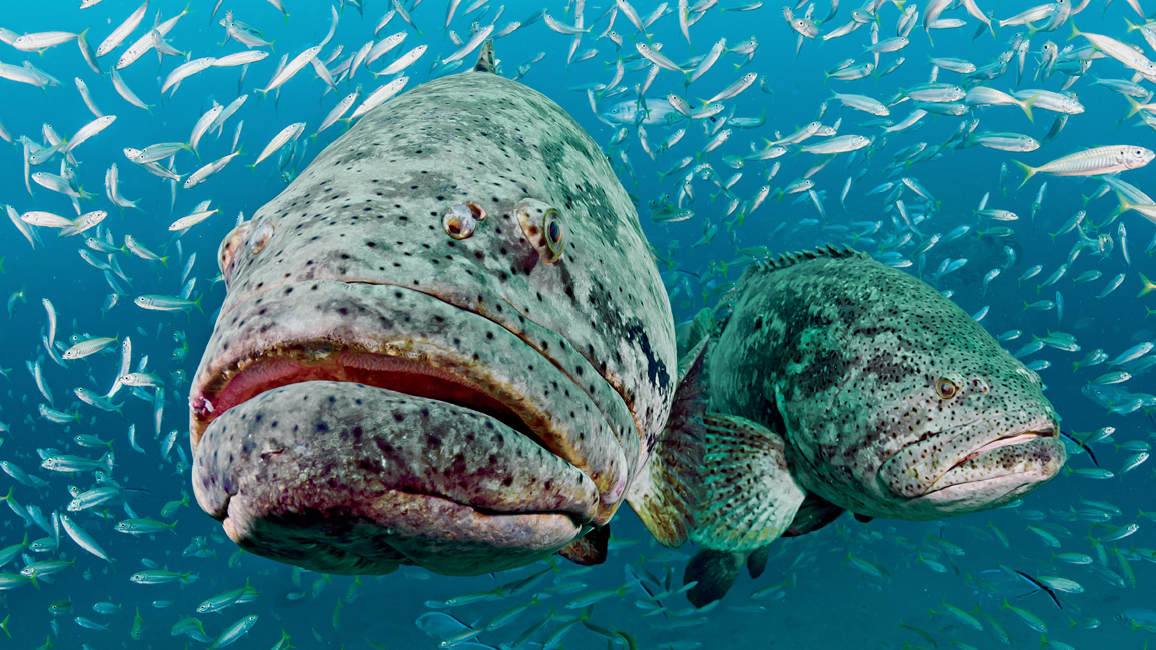
Super Groupers
By Gerry Bishop; photos by Michael Patrick O’NeillCheck out the two huge fish in this photo. They aren’t called goliath groupers for nothing. They’re among the largest species of fish in the world. They’re also among the most endangered. But now these super-sized fish are making a comeback. The more you know about them, the more you’ll agree that this is BIG news.
“Group” Photo
Surrounded by a school of minnows, a pair of goliath groupers poses for the camera. Come on, you two—smile!
Squeeze In, Everybody
Goliath groupers can be loners. But when mating season arrives, it’s time for them to get together. From all around—sometimes from hundreds of miles away—the huge fish gather into tightly packed groups. They peacefully bump and rub against each other while making loud, rumbling sounds. Whump, whump they go, as they get ready to release eggs and sperm into the water.
Fast Fact
There are more than 100 species of groupers. The goliath is the second largest, after the giant grouper of Australia.
Hey, Buddy!
Some goliaths, especially during mating season, become so tame they let divers pet them. This goliath, nicknamed Buddy, has become so friendly with divers that he follows them around, looking for handouts.
Fast Fact
Scientists think goliath groupers may start out life as females and then change to males as they get older.
Living Dangerously
Millions of small fish, such as these cigar minnows, often show up where the goliaths come to mate. They swarm around the goliaths, although scientists don’t know why. Are they waiting to gobble up eggs that the big fish release into the water? Whatever the reason, the goliath in this photo has done some feasting of its own. It has just gulped a mouthful of the tiny fish, with one still caught in its jaws.
Fast Fact
Young goliath groupers may be eaten by barracudas, sharks, moray eels, and even other groupers. But the huge adults have only the biggest sharks to fear.
I’m Warning You!
Goliath groupers are usually peaceful and friendly. But sometimes, when living alone, they don’t like intruders. If another goliath or other large fish gets too close, a goliath may open its mouth really wide.
Then it might shake its body and make that goliath rumbling sound. The warning is clear: “This place is mine!”
Homebodies
Rocky ledges and caves are favorite hideouts for goliath groupers. But a shipwreck also can be a great home.
When a goliath finds a good place, it usually stays put. That makes it easy for a fisherman to find and catch it. These fish are also easy to catch when they get together for mating.
For years, so many goliaths were caught that they were nearly wiped out. But fishing for them has been banned in many areas. Now their numbers are on the rise in some of those places, including along the coast of southern Florida and in the Gulf of Mexico. Good thing, because the seas would be a lot less interesting without these gentle giants.
Fast Fact
Goliaths love to hide out among rocks, reefs, and shipwrecks. Can you find parts of a sunken ship in each photo?
Where goliath groupers live:
- NORTH AMERICA
- AFRICA
- SOUTH AMERICA
- ATLANTIC OCEAN
- PACIFIC OCEAN
- Gulf of Mexico
“Super Groupers” originally appeared in the November 2015 issue of Ranger Rick magazine.
(Click on each image above for a closer view of the story.)



















